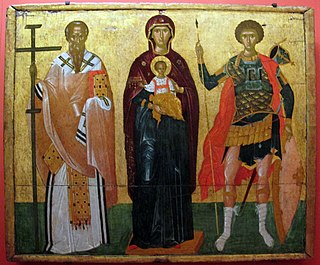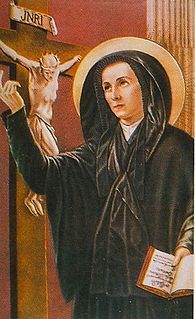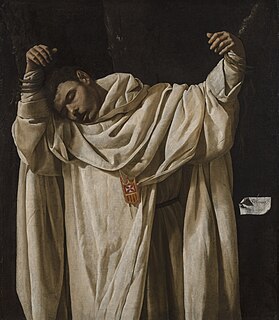Aspasius of Auch was a Christian leader of the 6th century canonized as a saint.

Saint Galation or Galaction was supposedly a martyr with his wife, Episteme, whom he converted. He was the son of Saints Kletophon and Leukippe, who were a rich and distinguished, but initially childless, pagan couple. When the couple was converted after being evangelized by a travelling monk/priest/beggar on the promise that the One true God would hear their prayers and grant them a child, Galaction was conceived and born. Galaction hoped from the beginning to live the monastic life, but he submitted in obedience to his parents and was betrothed to the beautiful pagan woman Episteme. During the course of their engagement, over subsequent visits Galaction converted first his fiancée and then her servant, Eutolmius. The couple went away to the mountain of Publion, Galaction to a men's monastery and Episteme to a women's. They did not leave their monasteries, and neither saw the other until the time of their death. A fierce persecution arose, and they were both brought to trial. When Galation was martyred under Decius at Emesa on 251 AD, Episteme went to his side and died with him. His feast day is November 5.

Cyriacus of Jerusalem was a bishop of Jerusalem who died during a riot in 133 AD. He is often misidentified with Cyriacus of Ancona.
Saint John IV, called the Peacemaker and known in Italian as Giovanni d'Acquarola or Giovanni Scriba, was the Bishop of Naples from 26 February 842 until his death. He is one of the patron saints of Naples and his feast day is 22 June. He had the relics of Aspren translated to the church of Santa Restituta in Naples. He also assisted Duke Andrew II in negotiating the Pactum Sicardi, an economic treaty, with Sicard, Prince of Benevento.
Saint Ava is a Roman Catholic saint. Ava was the daughter of Pepin. She was cured of blindness by St. Rainfredis. She then became a Benedictine nun at Dinart, Hainaut, located today in Belgium, and was elected abbess c. 845.
Elias of Jerusalem was a bishop and Patriarch of Jerusalem from 494 until he was deposed by Byzantine Emperor Anastasius I in 516 for supporting the decrees of the Council of Chalcedon. At the Synod of Sidon (512) he successfully defended, together with Flavian II of Antioch, the dyophysite Christological doctrine proclaimed by the Council of Chalcedon.
Sidonius was an Irish-born French monk and saint. He was the spiritual teacher of Leutfridus. He is venerated in the Roman Catholic Church and Eastern Orthodox Church.

Saint Aquilinus was a Frankish bishop and hermit. Born in Bayeux, he had been a warrior in the service of Clovis II and married in 660 at Chartres. He moved to Évreux with his wife, and both cared for the poor and sick in this town. In 670, he was named bishop of the city, but Aquilinus preferred to live as a hermit. His feast day is 19 October.
Saint Philetus, is along with Saints Lydia, Macedo(n), Theoprepius (Theoprepides), Amphilochius and Cronidas (Cronides), venerated as a Christian martyr.
Francis Ingleby was a Roman Catholic martyr executed in York, England during the reign of Elizabeth I.
Rictrude was abbess of Marchiennes Abbey, in Flanders. The main early source for her life is the Vita Rictrudis, commissioned by the abbey, and written in 907 by Hucbald.
Saint Aibertof Crespin, O.S.B., was a Benedictine monastic and hermit revered for his intense life of prayer, asceticism and devotion to the Rosary. His biography was written by a contemporary, Robert, Archdeacon of Oostrevand.

Lucy Filippini is venerated as a Catholic saint. She founded the Institute of the Maestre Pie, dedicated to the education of young girls.

Pope St. John XXIII National Seminary is a Roman Catholic seminary in Weston, Massachusetts. It offers a graduate-level program designed for priesthood candidates aged 30 and above, often called "second-career vocations" or "delayed vocations".

Saint Serapion or The Martyrdom of Saint Serapion is a 1628 oil on canvas painting by the Spanish artist Francisco Zurbarán (1598–1664). The work was commissioned by the Mercedarian Order to hang in the De Profundis hall of their monastery in Seville. Zurbarán is noted for his portrayals of penitent or martyred monks and saints. Critic Tom Lubbock used this painting to illustrate a difference in the way the martyrdom of two different saints were depicted. He contrasted the understated and calm depiction of St. Serapion's violent death, with the equally or more violent death of the Jesuit priest and martyr Saint Edmund Campion (1540–1581) who was publicly hanged, drawn and quartered in London in December 1581. The art critic draws a comparison in the manner of depiction of Campion's death and that of Saint Serapion of Algiers (1179–1240), a Mercedarian friar who fought in the Third Crusade of 1196 and was later martyred.

Felicitas of Padua is a saint in the Roman Catholic Church. She lived in the ninth century, and was a nun in Padua, probably at the convent of Saints Cosmas and Damian. Her relics are now in the Basilica of Saint Justina, Padua.
Saint Sixtus of Reims is considered the first bishop of Reims. According to Hincmar, a 9th-century archbishop of Reims, Sixtus was sent from Rome by Pope Sixtus II to Gaul to assist in Christianizing the region. Another tradition makes him, anachronistically, the disciple of Saint Peter. According to tradition, Sixtus of Reims, along with his companion St. Sinicius (Sinice), established the Christian sees of Reims and Soissons. Sinicius would later succeed Sixtus as bishop of Reims. According to one source, “it would appear that Sixtus did not die as a martyr, despite the severity of the persecution during the era.”
Warinus of Poitiers was the Franco-Burgundian Count of Poitiers and Count of Paris and later Saint Warinus, Martyr of the Franks. He was the son of Saint Sigrada of Sainte-Marie de Soissons and the brother of Saint Leodegarius. He was the father of Saint Leudwinus.
Januarius and Pelagia were joint Christian martyrs and saints recorded in the Jerusalem Martyrology. They were beheaded or racked and torn with iron claws and pieces of earthware at Nicopolis in Armenia during the reign of the Roman emperor Licinius. Their feast day observed on July 11. They are possibly to be considered identical with SS Januarius and Marinus who were martyred in the same place in the same year under identical circumstances with the martyrs Nabor and Felix; their feast day, however, was observed on July 10. Alternatively, the quartet may have been a combination of Januarius and Pelagia with the SS Nabor and Felix were martyred in Italy in the early 4th century.
Felix (d. 303) was a bishop of Thibiuca in Africa who was martyred during the Great Persecution under the Roman emperor Diocletian alongside Audactus, Fortunatus, Januarius, and Septimus. Felix is said to have resisted the command of the local magistrate Magnillian to surrender his church's copies of the Christian scriptures. In one account, Felix and the others were taken to Carthage and decapitated on July 15. These Five Martyrs of Carthage were venerated in the basilica of St Faustus. Another placed his martyrdom at Venosa in Italy. His companions may have been deacons but, apart from their joint martyrdom with Felix, are now unknown. Their feast day was observed jointly on October 24.






